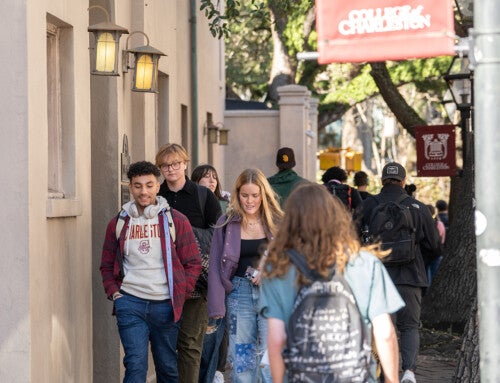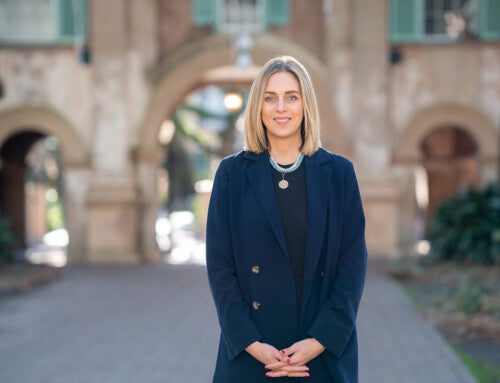The College of Charleston’s Department of Theatre will present a three-part event surrounding “Letters to Sala,” a play written by professor Beth Lincks. In addition to a production of the play in April 2012, there will be an exhibit in the Marlene and Nathan Addlestone Library dedicated to Sala’s story beginning January 4, 2012, and Lincks will speak on campus on Thursday, January 19, 2012.
Sala Garncarz was 16 years old in 1940, when she was sent from home to Geppersdorf, a German forced labor camp where Jewish men were building the autobahn and women worked in the laundry and kitchen. During her 5 years’ internment, which took her to seven different camps in Germany, Poland, and Czechoslovakia, Garncarz received more than 300 letters that were mailed or smuggled to her by friends and family on the outside or in camps themselves. Remarkably, she preserved these letters during her internment and continued to hide them for nearly five decades following her liberation and subsequent marriage to an American G.I., Sidney Kirschner.
“Letters to Sala: A Young Woman’s Life in Nazi Labor Camps,” a treasure trove of documents saved by one young woman during her five year ordeal of internment, will be on display from Wednesday, January 4 through Friday, January 27 on the second floor of the Addlestone Library (205 Calhoun Street). For the Library’s hours, please visit http://cofc.edu/library/libraries/hours/index.php. For more information contact Claire Fund at 843-953-8002.
The play, written by Arlene Hutton, pen name for College of Charleston’s playwriting teacher Beth Lincks, was based on the book “Sala’s Gift” by Sala’s daughter, Ann Kirschner. Lincks will speak at the College of Charleston on Thursday, January 19th at 6 p.m.
The College of Charleston’s Department of Theatre will present the play April 14 through April 19, 2012, at the Emmett Robinson Theatre. It will be guest directed by New York based Eric Nightengale, who directed Arlene Hutton’s “The Nibroc Trilogy” off-Broadway. For more information on the upcoming production including ticket sales, please contact the main Theatre office at 843-953-6306.
“The Department of Theatre is proud and excited to present this exhibition of Sala’s letters in conjunction with our production of Arlene Hutton’s play, “Letters to Sala,” said Department Chair, Todd McNerney. “Her letters are a testament to the spirit of perseverance, love, and hope present in all of us; and that spirit is even more forcefully and powerfully represented through the fortitude of a young girl faced with the most brutal and monstrous event of the twentieth century. The Theatre Department would like to thank the School of the Arts Quattlebaum Visiting Artist Fund for the financial support and the College of Charleston’s Marlene and Nathan Adlestone Library for the use of their space – both of which were necessary for us to bring this important exhibition to our campus and to Charleston.”
The power of the written word to sustain life is a theme of Letters to Sala: A Young Woman’s Life in Nazi Labor Camps. Sala Garncarz saved the items — from handwritten postcards to photographs to official documents — from the time she entered a labor camp in 1940 until her liberation in 1945. The exhibition, a graphic narrative through facsimiles, provides a remarkable first-hand view of the human drama that unfolded among Jews forced to work as slave laborers during the war. “Letters to Sala” is curated by Jill Vexler, and on loan from the New York Public Library and the French Children of the Holocaust Foundation.
“My family and I are delighted that, through The New York Public Library’s exhibition Letters to Sala, the public will have the opportunity to learn my mother’s incredible story of survival and courage,” said Ann Kirschner. “When the world seemed entirely hostile, a young girl found refuge and hope in these remarkable letters written by her family and friends. Their words will now be preserved and made accessible to the historians and artists whose insights will help future generations to understand the lessons of the past.”
The exhibition presents approximately 100 postcards, letters, photographs, documents, and other artifacts drawn primarily from the Sala Garncarz Collection of the New York Public Library’s Dorot Jewish Division. The total archive, which encompasses more than 300 items that Sala Garncarz collected and saved at great personal risk during her five years interned in Nazi labor camps, was donated to the Library in 2005 by Sala Garncarz Kirschner and her family.
The letters on display impart details about Jewish life in occupied Poland, Nazi labor camps, and the human ability to reconstruct life. For Garncarz, the letters provided evidence that her world still existed outside the camps and that her existence within it still mattered. Some carefully handwritten in elegant prose, others hastily jotted down, highlighting the urgent circumstances of their composition, the letters were her lifeline to the friends and family waiting for her return. Saving the letters became inextricably linked with preserving her own life.
The letters portray a young woman through the eyes of those who loved her: her sister, Raizel Garncarz, who wrote on behalf of herself and the immediate family; a suitor, Harry Haubenstock, whom she met in a camp; and Ala Gertner, a campmate who looked after her and stayed in touch with her by mail after they were separated.
“The letters that comprise this exhibition are the true embodiment of how the written word can give life,” said curator Jill Vexler. “What emerges from the exhibition is an inspiring portrait of human resilience in the face of unthinkable atrocity.”
Upon liberation in 1945, Sala located two of her sisters, the only surviving members of her family. Resuming the life-affirming correspondence, her sister Raizel wrote, “I did not doubt that you were alive, but I could not figure out how you — the one of us who knew best how to survive – remained silent … Once more, we live for your letters.” Her love of years earlier, Harry Haubenstock, had married another, and less than a year after her camp was liberated, Garncarz married Sidney Kirschner, an American soldier, and moved to the United States.
The letters were hidden away for decades following the war, until Garncarz revealed their existence to her daughter, Ann Kirschner, before undergoing cardiac surgery in 1991. Ann is author of SALA’S GIFT: My Mother’s Holocaust Story (The Free Press), which has been translated into Polish, German, French, Italian, Mandarin Chinese and as of March 2012, Czech. She is also the Dean of Macaulay Honors College of CUNY. The exhibition has been on tour since 2007 and has appeared in about 20 cities in the United States and Poland, and in the United States Senate Rotunda. Sala’s letters are also the subject of a play by Arlene Hutton and a documentary film by Murray Nossel.
Sala Kirschner currently lives in Monsey, New York and Pembroke Pines, Florida.



